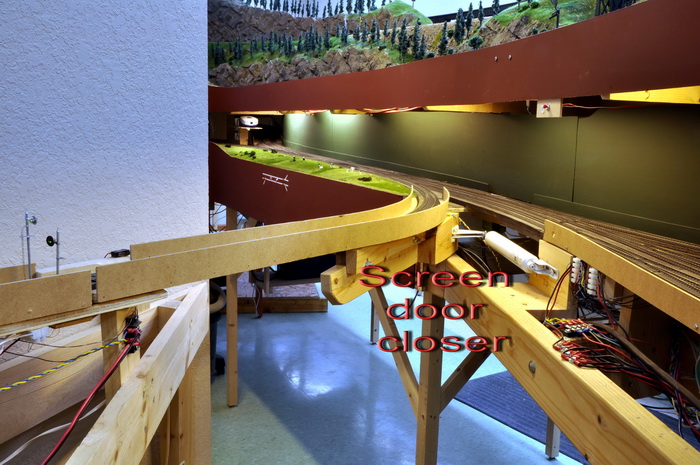
Swing Bridge |
This article is about a swing bridge that carries a track from the lower level reverse loop across an aisle to connect with the staging yard throat. The bridge is opened by simply pushing it out of the way, walking through, and releasing it. A screen door closer takes care of closing it. The bridge pivot is an ordinary door hinge located just behind the arm that attaches the screen door closer to the bridge.
The bridge roadbed is 1/2 inch plywood re-enforced with two strips of 1/4 inch masonite nailed and glued with yellow carpenter's glue to edges of the roadbed. The roadbed is supported by an arm attached to the door hinge. The arm is made of two overlapping pieces of wood cut from one by fours. The arm pieces are bolted together through two slots. The bolts and slots provide a means adjusting the height of the end of the bridge. Click on the photos to enlarge them. Use your back button to return.
The next photo shows the bridge in the open position. Notice the end of bridge roadbed is tapered from right to left. As the bridge closes this tapered end meets a similar tapered surface on the platform where the bridge end rests when the bridge is closed. These tapered surfaces are shaped so that the end of the bridge comes to just the right height for the rail ends to match vertically when the bridge is closed.
In the following photo, you can see the tapered striker plate that brings the bridge end to correct elevation. There is also a vertical stop that brings the rails into correct horizontal alignment when the bridge closes. The white squares are pieces of tape added to adjust the horizontal position of the bridge end.
The last photo shows the bridge end in the closed position. The micro switch provides a bridge status indication to the computer software. The control program then accounts for this in setting the signals at the bridge end and in displaying the bridge status on the command station monitors. The control program also kills or enables the track power to the bridge approaches. If the staging yard throat turnout is not routed to the bridge, power to that approach remains on when the bridge is opened so as not to interfere with staging yard operations.